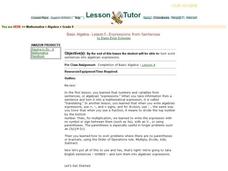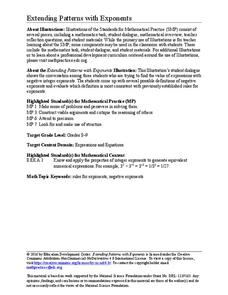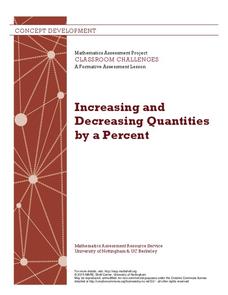EngageNY
Understanding Addition of Integers
Count up or down to find sums. The third lesson in a 25-part series uses number lines to build an understanding of the sums of integers. Pupils make the connection between the distance and direction of a sum from the first addend, then...
CK-12 Foundation
Geometric Sequences: Bacteria Colony
Show budding mathematicians how to model a diminishing bacteria colony two ways—graphically and algebraically. Using the coordinate axis, pupils create a graph to represent the decay of a bacteria colony. They determine the number of...
Curated OER
Expressions from Sentences
In this algebra instructional activity, students rewrite sentences into algebraic equations using variables and solve for the unknown. There are 10 interactive questions with an answer key.
Jordan School District
Picture Frames and Algebra
Middle schoolers create a method for finding the area of a fame for a picture and then transfer their shared methods into algebraic expressions. They develop the algebraic language to communicate and solve problems effectively and...
Curated OER
Distributive Property
In this Algebra I worksheet, 9th graders use the distributive property to simplify algebraic expressions. The one page worksheet contains twenty multiple choice problems. Answers are provided.
Curated OER
The Distributive Property
For this algebra worksheet, students use the distributive property to solve expressions. They distribute negatives and numbers to get the correct answer. There are 30 questions relating to distribution.
Curated OER
The Distributive Property
In this algebra worksheet, students solve problems using the distributive property and combine like terms to simplify the expression or equation. There are 24 problems.
Curated OER
The Distributive Property #4
In this distributive property learning exercise, students simplify 26 expressions. Students simplify by using the distributive property and combining like terms.
Curated OER
Power Laws
In this power laws worksheet, students solve and complete 6 different types of problems. First, they express each using powers and write in index form with a given base. Then, students calculate each problem and write in simplest terms.
Curated OER
Identity, Inverse, and Equality Properties
In this properties instructional activity, 9th graders solve and complete 29 various types of problems that include identifying various types of properties. First, they give an example of each property named. Then, students name the...
Mathematics Vision Project
Module 1: Getting Ready Module
This fabulous resource is a must-have for any algebra teacher's arsenal of lessons. Developing the idea of equations and use of variables from basic physical scenarios, learners gain valuable intuition in the structure and meaning of...
Inside Mathematics
Two Solutions
Many problems in life have more than one possible solution, and the same is true for advanced mathematics. Scholars solve seven problems that all have at least two solutions. Then three higher-level thinking questions challenge them to...
Mathematics Vision Project
Module 3: Polynomial Functions
An informative module highlights eight polynomial concepts. Learners work with polynomial functions, expressions, and equations through graphing, simplifying, and solving.
Mathematics Assessment Project
Solving Linear Equations
Linear equations are the focus of activities that ask learners to first complete a task that involves interpreting algebraic expressions and solving linear equations. They then take part in a card activity matching...
Education Development Center
Extending Patterns with Exponents
Don't think negatively about exponents. Young mathematicians dissect a fictional conversation between pupils trying to evaluate an expression with a negative exponent. This allows them to understand the meaning of negative exponents.
Achieve
Spread of Disease
Viruses can spread like wildfire, and mathematics can model the speed of infection. Given a function, scholars analyze it to describe the spread of a disease within a stadium. Learners find the initial number infected and the maximum...
Mathematics Assessment Project
Increasing and Decreasing Quantities by a Percent
As part of a study of percent and percent change, learners first complete an assessment task with several percent change problems. They then complete an activity using cards to create a diagram expressing percent increases and...
EngageNY
Comparing Methods—Long Division, Again?
Remember long division from fifth grade? Use the same algorithm to divide polynomials. Learners develop a strategy for dividing polynomials using what they remember from dividing whole numbers.
EngageNY
The Relationship of Division and Subtraction
See how division and subtraction go hand-in-hand. The fourth installment of a 36-part module has scholars investigate the relationship between subtraction and division. They learn using tape diagrams to see that they can use repeated...
Illustrative Mathematics
Bowling for Numbers
When do teams want a strike? When they are playing this fun math game modeled after bowling. First, class teams roll four dice to generate the numbers they will use in that round, called a frame, of the game. Next, pins numbered 1...
Curated OER
Using Algebra Tiles to Explore Distributive Property
Math is fun with algebra tiles! Young mathematicians explore eight expressions involving the distributive property and use algebra tiles to expand simple expressions. The resource is perfect for both guided and independent practice.
EngageNY
Putting It All Together
Shuffle 'em up and deal! Learners practice operations with polynomials using cards they pass around the room. The activity works with pairs or individuals, so it offers great flexibility. This is the fifth installment in a series of 42...
Curated OER
Throwing Horseshoes
Collaborative learners interpret a quadratic expression written in different forms in this task centered on throwing horseshoes.
Agile Mind
Rabbit populations
For this real-world problem about the rapid growth of rabbit populations, students must analyze two different scenarios and create mathematical models to represent them. They use their exponential models to answer questions about the...























